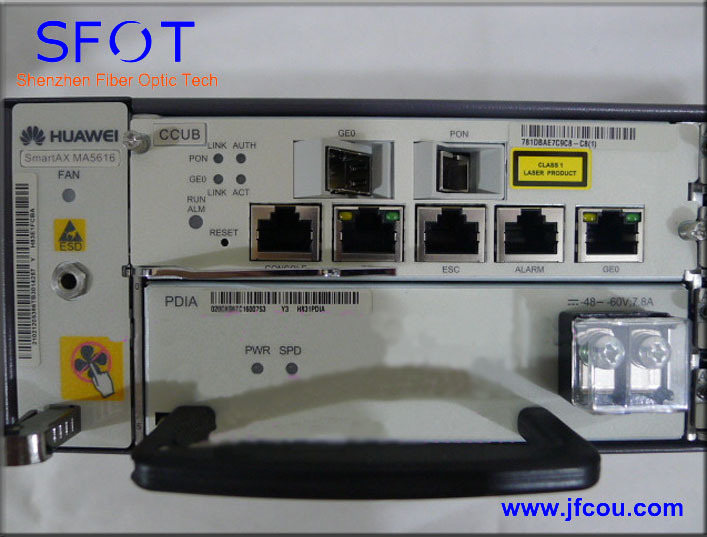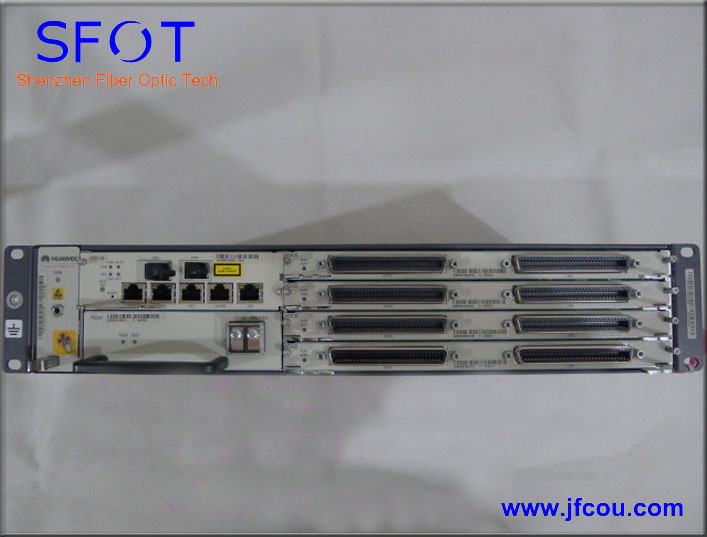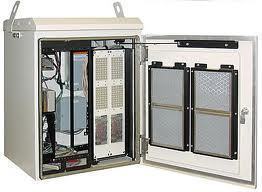Digital Subscriber Line Access Multiplexer
A Digital Subscriber Line Access Multiplexer (English " DSL access concentrator ", short DSLAM ) is a part of the necessary for the operation of DSL infrastructure. DSLAMs are in a place to converge towards the subscriber lines. Usually it involves an exchange, but also partly decentralized Aufschaltpunkte, eg in large office or residential complexes.
The DSLAM is located within the central office, one speaks of an "indoor DSLAM ", in another case of a "Outdoor - DSLAM ". In technical jargon, the exchange of the DSLAM is called a Central Office ( CO), partly with the preamble Central Office Equipment (COE ).
- 2.1 Line Cards
- 2.2 Network Interface
- 2.3 Management
- 3.1 Technical regulation
Function
The DSLAM terminates with its line cards, the subscriber lines, collects (or distributed ) at the local level of the high- traffic retail and passes it over the so-called concentrator to a regional broadband access server that is responsible for IP routing and PPPoE termination is.
The DSLAM is the counterpart to the broadband modem at the subscriber. The DSLAM sets in the training phase fixed (synchronization phase ) to the DSL modem, which frequencies can be used for broadband transmission. Since it comes in a cable through different connections to interference, possibly all frequencies can not be used. In the training phase, all frequencies ( for ADSL ITU-T G.992.1 Annex B, the frequency range is from 138 kHz to 1100 kHz) tested and the frequencies at which bad packets arrive or not arrive, as unusable "marked". This training phase is important in order to ensure a quality DSL connection that is free of synchronization losses and crashes. In a DSLAM profile remains stored, where it is stored, what speeds with the DSL connection in the upstream and downstream synchronized maximum. This profile will continue to be stored, which results in minimum SNR margin is required, and whether the data are transmitted interleaved or not ( Fastpath ). If the values can not be met due to high attenuation on the line, it can, depending on the profile (for example, fixed- rate) lead to constant crashes, or it will lower transmission speeds negotiated (flexible - rate profile).
With ADSL2 ports, it is technically possible during an ongoing connection (synchronization) to disable individual frequencies or reenable. This technique is however currently not used anywhere.
Some providers are already offering pure DSL connections. The telephony is here implemented via VoIP. In this type of connection, the splitter can be omitted.
DSLAM (ATM)
The broadband data traffic is transmitted in both directions in ATM cells. The IP data packets are transported in the payload of the ATM cells. The task of the DSLAM is to convey the power coming from the ATM cells to the correct subscriber ports and vice versa. In the OSI model corresponds to this ATM switching function of a layer 3 function. For the PPPoE on Ethernet fitting end and thus the Internet protocol (IP ) of the DSLAM is transparent. Some ADSL modems can also directly access the ATM layer. For PPPoA is even necessary. Normal ADSL modems but hard-wired ATM parameters and shake it fitting end Ethernet layer by. Although this has the disadvantage of a slightly higher overhead, but the advantage of easy usability by normal Ethernet network cards.
IP DSLAM
IP stands for Internet Protocol DSLAM Digital Subscriber Line Access Multiplexer. IP DSLAMs terminate the IP traffic directly and guide him in an IP network. In addition, they can take a routing function.
Components
The DSLAM has three essential components: line cards, a network interface and a clock supply.
Line Cards
The DSLAM is equipped with slots for so-called line cards. These line cards are the ports for the wires going to the participants summarized. Depending on the design are ports on a line card 2, 8, 12, 16, 24, 32, 48, 64, 72 or 96. A port consists essentially of a transceiver unit ( ATU -C ADSL, ADSL Transmission Unit Central Office called ), as well as a splitter, if the line is also used for high-speed data traffic and voice calls. The ATU- C is used for receiving the upstream signal, and transmits the downstream signal. The splitter can be accommodated depending on the design on the line card or externally mounted.
Network interface
The second essential component of the DSLAM is the Network Interface, the rear is connected to a DSL -AC. Mostly used for this purpose ATM over fiber optic cables, for example, an STM-1 connection to 155 Mbit / s bandwidth, rarely radio. In particular, smaller city carriers use to connect the DSLAM to the backbone network, a Gigabit Ethernet port ( electrical or optical). The bandwidth of the uplinks can share with optional slave master a DSLAM, which can be cascaded to the master. This results in some products cause the DSLAM master can not be fully populated with line cards, as the modules for cascading in the master and slave must be used. Another way is to cascade daisy-chaining.
Management
Furthermore, there is a LAN interface ( LCT Local Craft Terminal), with the DSLAM is connected to a management network, from which it gets its configuration and can be managed with some models. Alternatively, the management can be carried out in-band in many DSLAM. Here, the data management in ATM uplinks within a given PVC ( see Virtual Circuit ) or transmitted in Ethernet uplinks in a specific VLAN.
Outdoor DSLAM
In areas where the cable has been realized up to the vicinity of the customers with fiber optic lines ( OPAL, HYTAS ), the DSL termination must take place there, where the transition from fiber optic cables to copper takes place, so for example in the building itself or in the street cabinet. This is done by means of devices, referred to as an outdoor or mini- DSLAM, DSLAM. These are considerably smaller than the DSLAMs in the exchanges because they have far fewer connections.
Outdoor DSLAMs also be used in connected by means of conventional copper lines connecting areas where sufficient broadband supply due to too great a distance to the exchange (ie, due to excessive line loss of the DSL signal ) is not possible.
The great advantage of this arrangement is that very high bandwidths are possible because of the very short copper lines between DSLAM and subscriber, and so, for example, VDSL can be used. Disadvantage is the much higher cost per participant, which the DSL coverage in large parts of eastern Germany - continue progressing relatively slowly and in areas far away from the exchanges - the main application area of the OPAL technology. Alternatively, the fiber optic cabling has been extended into every building in the area affected into within a GPON pilot project.
Technical regulation
If in the catchment area of an outdoor DSLAM at the same time also supplied from the central office DSL connections are connected, the outdoor DSLAM must be limited to parts of the frequency range, the transmission power in order to avoid disturbances of the exchange- supplied connections by crosstalk. Most often this is the fact that the affected DMT tones during the synchronization phase artificially strongly damped and thus are not or only weakly occupied in the result. The process is called Downstream Power Back- Off ( DPBO ) and is normalized in the ITU standard G.997.1. When installing an outdoor DSLAM initially the damping of the exchange is measured to be supplied to the street cabinet (main cable attenuation ). From this a value is determined, which can then be inserted into the formulas for calculation. Decisive here are the network compatibility reports " Test Report 5" for ADSL and " test report 3" for VDSL. On the outdoor DSLAM corresponding profiles are then set up. The active from outdoor DSLAM at Port DPBO profile leads to a spectrally adjusted power distribution, which causes starting from the low frequencies an increase in attenuation to a, also from the measured value with the test reports to be calculated upper limit frequency (MUF ). From this upper limit frequency is no longer expected from MDF with a usable DSL signal. It is apparent that the frequency MUF (maximum usable frequency ) depends on the length and nature of the main cable ( cable from the exchange to the street cabinet ). Therefore, DSL 6000 and slower connections in the form of ADSL2 are switched on outdoor DSLAM typically and can therefore, if DPBO must be used, avoid the used only ADSL2 frequency range from 1.1 to 2.2 MHz. In the same way, take a VDSL2 DSLAM consideration for main distributor supplied ADSL2 ports by omits the frequency range up to 2.2 MHz as possible.
Importance in the broadband market
DSLAMs provide on most telecommunications markets, the most common network element for broad band connection of stations to the network of Internet providers and is used by both incumbents and competitors.
Competitors get this at the main distribution access to the local loop and co-location space to rent in the local exchanges of the incumbent operators where they place their own DSLAMs and connected to its concentrator. This access of competitors is called unbundling (English unbundled local loop ) or in the specific case and line - sharing.
For outdoor DSLAMs a corresponding method (sub loop unbundling ) is not yet available. In Germany, the Federal Network Agency is currently ( mid-2007 ) in creating the conditions for this.
Alternatively reach Internet provider in the so-called bitstream access their clients about the DSLAMs from the incumbents, while this usually can specify the DSLAM switch profiles, but this is not implemented in Germany violation of the relevant ERG position by the Federal Network Agency.
The use of their own technology, however, allow in Germany collocation variants at the cable or at the switching manifold. It built the alternative provider 's own system technology (usually in outdoor housing ) near the customers, that binds via cross cable to the street cabinet or switching distributor of telecom and rents the TAL to the customer either exclusive or ( since mid-2011 ) in the line-sharing method.









